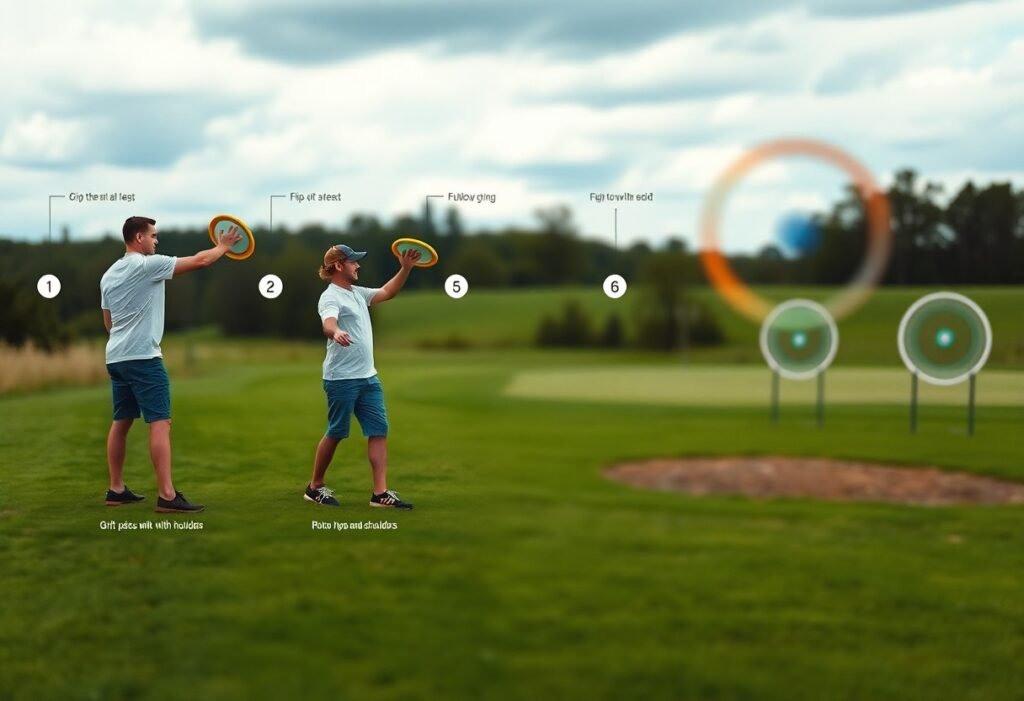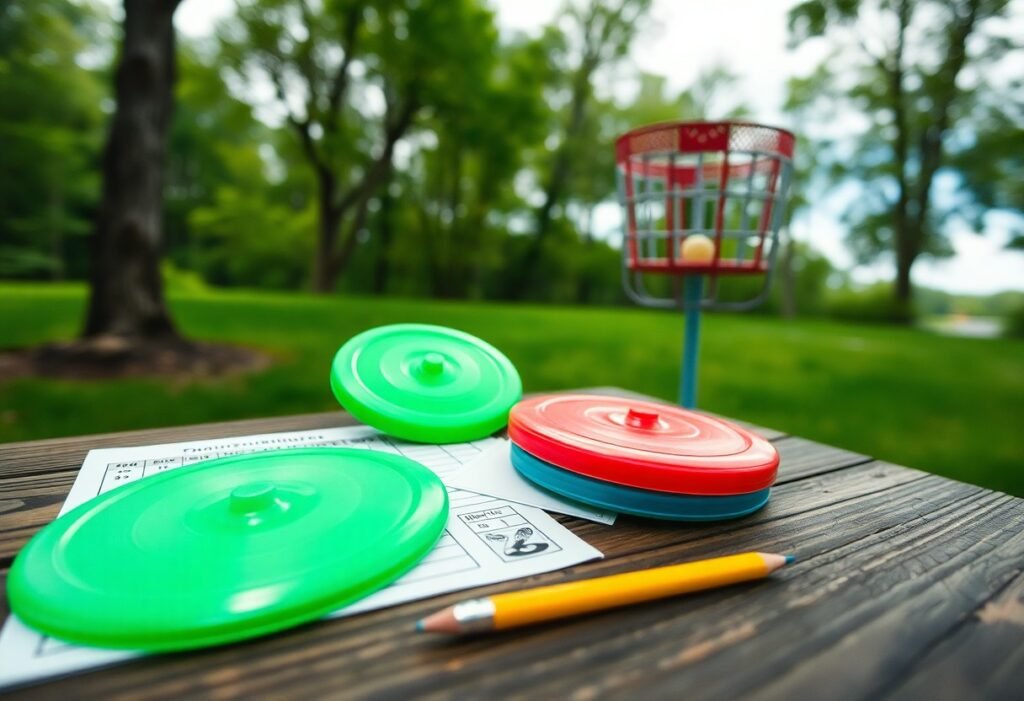Rules govern the flow of disc golf, ensuring fair play and a fun experience for everyone involved. As you initiate on your disc golf journey, it’s important to understand the basics: starting with the tee throw, following strokes per hole, and knowing how to handle obstacles like out-of-bounds areas. Visualizing the course and keeping score also enhances your game. By grasping these fundamental rules, you will not only improve your skills but also enjoy the camaraderie and competition that disc golf offers.

Key Takeaways:
- Players throw a disc from a tee pad toward a target, usually a basket, following a designated course layout.
- Each thrown disc counts as a stroke, and the objective is to complete the course in the fewest strokes possible.
- Players must observe out-of-bounds areas, take appropriate penalties, and follow specific rules related to disc gathering and throwing order.
Understanding Disc Golf
What is Disc Golf?
Disc golf is a dynamic, outdoor sport that combines traditional golf concepts with frisbee throwing. Instead of hitting a ball into a hole, you throw a specialized disc towards a series of elevated baskets, aiming to complete the course in as few throws as possible. The game is accessible, making it easy for players of all skill levels to enjoy.
Brief History of Disc Golf
The origins of disc golf date back to the 1960s when enthusiasts began throwing frisbees at targets such as trees and trash cans. The formalization of the game occurred with the establishment of courses and rules in the 1970s, leading to the creation of disc golf associations and tournaments.
In 1975, the first official disc golf course was built in Pasadena, California, marking a significant step in the sport’s development. As play evolved, notable figures like Ed Headrick contributed to standardizing rules and promoting the sport, ultimately culminating in the formation of the Professional Disc Golf Association (PDGA) in 1976. This increased organization and visibility spurred rapid growth, with today’s disc golf scene comprising thousands of courses and millions of players worldwide.
Overview of Objective and Gameplay
Your objective in disc golf is to complete each hole in the fewest number of throws, similar to traditional golf. Each course typically consists of 9 or 18 holes, featuring varying distances and obstacles that require strategic throwing techniques.
Gameplay begins at the tee pad, where you throw your disc toward the basket, marked by the target. Each throw is counted, and if you miss the basket, you will play your next shot from where the disc landed. The player with the lowest overall score at the end of the course wins. Many players enjoy practicing different throws, honing their skills to tackle diverse course designs and improve their game strategy.

The Basics of Disc Golf Equipment
Types of Discs
Choosing the right disc is crucial for your game. There are three main categories of discs: drivers, midranges, and putters. Each type serves a unique purpose, with drivers designed for long-distance throws, midranges for accuracy, and putters for short, precise shots. Understanding these types allows you to select the right disc for specific situations on the course.
- Driver: Best for long throws.
- Midrange: Great for accuracy.
- Putter: Ideal for short, controlled shots.
- Weight: Varies by personal preference.
- Plastic Types: Affects durability and grip.
After understanding the different types, start experimenting with each to find out which best suits your style of play.
| Disc Type | Purpose |
| Driver | Long-distance throws |
| Midrange | Versatile shots between drives and putts |
| Putter | Short, precise shots |
| Distance | How far you can throw |
Essential Gear
While discs are the heart of your game, having the right gear is equally important. A comfortable, weather-appropriate outfit enhances your performance, along with a quality disc golf bag to carry your equipment. Make sure to bring along water for hydration, as disc golf often involves prolonged outdoor activity.
Besides discs and a bag, investing in a pair of sturdy shoes will significantly improve your traction and stability on various terrains. Additionally, consider a durable towel to keep your discs dry and a scorecard to track your progress. Comfort and preparedness play vital roles in maximizing your enjoyment on the course, allowing you to focus on your skills. Having these crucials can elevate your playing experience, helping you concentrate on your throws and strategies.

The Course Layout
Course Structure
The layout of a disc golf course typically consists of 9 to 18 holes, featuring designated tee pads and basket targets. Each hole varies in length and difficulty, with some spanning hundreds of feet, while others may include tight turns or obstacles like trees and water. A standard course will guide you from the tee pad to the basket, often marked by signs indicating distance and par, making understanding the flow of the course necessary for your strategy.
Understanding Par and Scoring
Par is a fundamental element of disc golf, representing the number of throws an experienced player is expected to take to complete a hole. Each hole has a designated par, typically ranging from 3 to 5 strokes. Scoring is straightforward: if you finish a hole in fewer throws than par, you score a birdie; if you take more throws, it’s a bogey. Tracking your scores over the course will help you gauge your performance and progress.
Understanding par extends beyond just finishing the hole. For instance, playing a par 3 hole means you should ideally complete it in three throws, while a par 4 would suggest four. The total score across a round combines the par for each hole, allowing a direct comparison to others’ scores. This basic scoring system promotes healthy competition, as you strive to improve your game while aiming for lower scores throughout your rounds.
Fundamental Rules of Play
Starting Play
To begin play, you start at the designated tee pad of the first hole. You must have one foot behind the tee line when you throw your disc, setting the stage for your initial shot. All players in your group take turns throwing from the tee until everyone has completed their first throw, ensuring that you respect the flow of the game.
Playing the Disc
After your throw, you’ll need to follow the flight of your disc and determine its landing position. The next throw is taken from where the previous disc has landed, with the player furthest from the basket throwing first for every turn. This sequence continues until all players have completed the hole.
When playing the disc, it’s vital to throw from within the established margins of the previous throw’s location. If your disc lands out of bounds, you will take a stroke penalty and throw from the last in-bounds location. Also, be cautious of obstacles; if your disc lands behind a tree or in thick brush, you must ensure an unobstructed throw to maintain pace. Various course conditions could influence your strategy, so staying aware of your surroundings will improve your experience.
Etiquette and Sportsmanship
Basic Etiquette Guidelines
In disc golf, proper etiquette ensures an enjoyable experience for everyone. Always be mindful of your surroundings and avoid making noise while others are throwing. Maintain a steady pace of play; if you’re slower than your group, let faster players pass. Respect the course by picking up any litter and staying on designated paths. Lastly, keep your distance from other players’ throwing lines to avoid distractions or potential injuries.
Communicating with Fellow Players
Effective communication enhances your disc golf experience. Always announce your throw and make sure everyone is ready before you throw. If you’re unsure about a ruling or need to discuss a situation, do so respectfully and keep your voice down to maintain a focused environment. By doing this, you foster a positive atmosphere.
When discussing course rules or potential disputes, approach your fellow players calmly and with an open mind. Use phrases like “Can we talk about…” instead of accusations, keeping the conversation productive. Your tone should encourage collaboration instead of conflict. If a player performs well, compliment their skill; this not only promotes camaraderie but also makes the game enjoyable. Strong communication fosters a community feel on the course, which is important for a great disc golf experience.
Special Situations in Disc Golf
Out of Bounds (OB)
When your disc lands outside the designated boundary lines, it is considered Out of Bounds (OB). This typically applies to areas like roads, water, or marked zones. If you land OB, you must take a penalty stroke and throw your next shot from the point where the disc crossed the boundary, which is called the point of exit.
Hazards and Natural Obstacles
Hazards can include areas that present unique challenges, such as rivers or ponds, while natural obstacles encompass trees and bushes that affect your throwing line. You must navigate these hurdles carefully as they can significantly impact your score.
Hazards often result in a penalty stroke if your disc lands within them. For instance, when throwing from a river bank, you may need to determine if your disc is submerged or reachable, as this affects your next shot’s placement. Similarly, dense brush can make it difficult to locate your disc and may require you to take a stroke and throw again from a nearby safe area.
Unplayable Lies
Sometimes, your disc may land in a position that makes it unplayable, such as under a downed tree or in a thick bush. In these cases, you can declare your lie unplayable and opt for a relief option that involves taking a penalty stroke.
When addressing an unplayable lie, you must choose where to throw from, typically either within two meters from the original lie or back along the line of flight. Ensure you take note of any potential obstacles and avoid losing sight of the disc’s original position, as moves away from it may lead to additional strokes.
Summing up
Now that you have a solid understanding of the basic rules of disc golf, you can confidently hit the course and enjoy the game. Familiarizing yourself with the rules enhances your experience and respect for the sport. If you’re looking for more in-depth information as you start your journey, check out An Absolute Beginner’s Guide to Disc Golf : r/discgolf. Good luck, and have fun playing!
FAQ
Q: What is the objective of disc golf?
A: The objective of disc golf is to complete a course by throwing a disc from a designated tee area into a target, usually a metal basket, in the fewest number of throws.
Q: How do I start a game of disc golf?
A: To start a game, players take turns throwing from the tee pad. The player with the best previous score typically goes first on the next hole.
Q: What are the different types of discs used in disc golf?
A: Disc golf utilizes three primary types of discs: drivers for long-distance throws,Mid-range discs for versatility, and putters for short, accurate throws into the target.
Q: What are the rules for throwing a disc?
A: Players must throw from within the designated tee area. After the initial throw, players must throw from where their previous throw landed, staying within the surrounding space.
Q: What is a “stroke” in disc golf?
A: A stroke is counted each time a player throws their disc. The total number of strokes taken to complete the course determines a player’s score.
Q: Are there penalties in disc golf, and how do they work?
A: Yes, penalties can occur for various rule violations, such as throwing out of bounds or losing a disc. Common penalties include adding strokes to the player’s score or re-throwing from the previous location.
Q: How is the winner determined in disc golf?
A: The winner is the player with the lowest total score at the end of the course, which is the sum of all strokes taken across the holes played.











